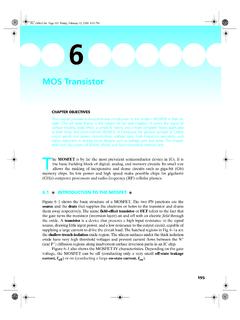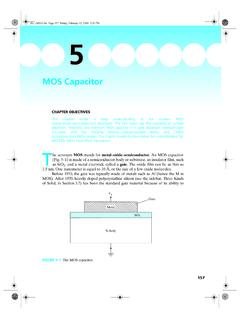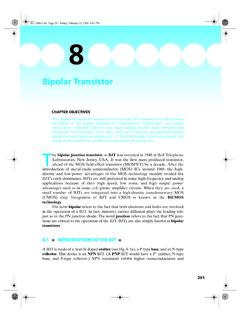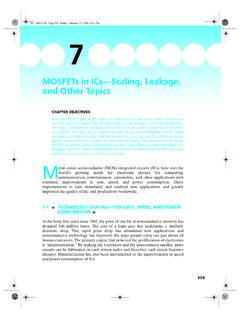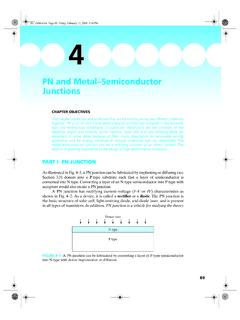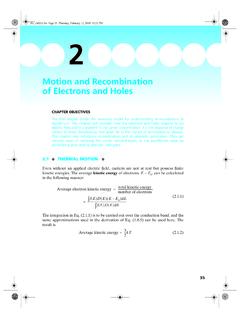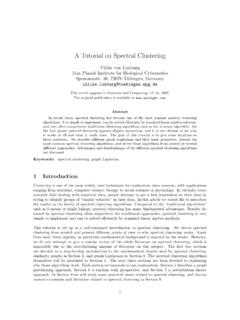Transcription of Electrons and Holes in Semiconductors
1 11 Electrons and Holes in SemiconductorsCHAPTER OBJECTIVESThis chapter provides the basic concepts and terminology for understandingsemiconductors. Of particular importance are the concepts of energy band, the twokinds of electrical charge carriers called Electrons and Holes , and how the carrierconcentrations can be controlled with the addition of dopants. Another group ofvaluable facts and tools is the Fermi distribution function and the concept of the Fermilevel. The electron and hole concentrations are closely linked to the Fermi level.
2 Thematerials introduced in this chapter will be used repeatedly as each new device topic isintroduced in the subsequent chapters. When studying this chapter, please payattention to (1) concepts, (2) terminology, (3) typical values for Si, and (4) all boxedequations such as Eq. ( ).he title and many of the ideas of this chapter come from a pioneering book, Electrons and Holes in Semiconductors by William Shockley [1], publishedin 1950, two years after the invention of the transistor. In 1956, Shockleyshared the Nobel Prize in physics for the invention of the transistor with Brattainand Bardeen (Fig.)
3 1 1).The materials to be presented in this and the next chapter have been foundover the years to be useful and necessary for gaining a deep understanding of alarge variety of semiconductor devices. Mastery of the terms, concepts, and modelspresented here will prepare you for understanding not only the manysemiconductor devices that are in existence today but also many more that will beinvented in the future. It will also enable you to communicate knowledgeably withothers working in the field of semiconductor CRYSTAL STRUCTUREA crystalline solid consists of atoms arranged in a repetitive structure.
4 Theperiodic structure can be determined by means of X-ray diffraction and electronmicroscopy. The large cubic unit shown in Fig. 1 2 is the unit cell of the silicon Page 1 Thursday, February 12, 2009 10:14 AM2 Chapter 1 Electrons and Holes in Semiconductorscrystal. Each sphere represents a silicon atom. This unit cell is repeated in allthree directions many times to form a silicon crystal. The length of the unit cell, , in Fig. 1 2, is called the lattice most important information from Fig. 1 2 is the simple fact that each andevery silicon atom has four other silicon atoms as its nearest neighbor atoms.
5 Thisfact is illustrated in Fig. 1 2 with the darkened cluster of a center atom having fourneighboring atoms. This cluster is called the primitive cell. Silicon is a group IVelement in the periodic table and has four valence Electrons . These four electronsare shared with the nearest neighbors so that eight covalent Electrons are associated Inventors of the Transistor Born on three different continents (Brattain in Amoy, China; Bardeen in Madison,Wisconsin, USA; and Shockley in London, England), they all grew up in the UnitedStates and invented the transistor in 1947 1948 at Bell Telephone was an experimentalist while Bardeen and Shockley contributed more tothe concepts and theories.
6 Their reflections on that historic event: .. after fourteen years of work, I was beginning to give up .. Walter H. Brattain (1902 1987) Experiments that led to the invention of the point-contact transistor by WalterBrattain and me were done in November and December, 1947, followed closely bythe invention of the junction transistor by Shockley. John Bardeen (1908 1991) All of us who were involved had no doubt that we had opened a door to a newimportant technology. William B. Shockley (1910 1988)FIGURE 1 1 Transistor inventors John Bardeen, William Shockley, and Walter Brattain (leftto right) at Bell Telephone Laboratories.
7 (Courtesy of Corbis/Bettmann.) Page 2 Thursday, February 12, 2009 10:14 Silicon Crystal Structure3with each atom. The structure shown in Fig. 1 2 is known as the diamond structurebecause it is also the unit cell of the diamond crystal with each sphere representinga carbon atom. Germanium, the semiconductor with which the first transistor wasmade, also has the diamond crystal structure. Figure 1 3 introduces a useful system of denoting the orientation of thesilicon crystal. The cube in Fig. 1 3a represents the Si unit cell shown in Fig. 1 2 andeach darkened surface is a crystal plane.
8 The (100) crystal plane in the leftmostdrawing in Fig. 1 3a, for example, is simply the plane in Fig. 1 2 closest to thereader. It intersects the x axis at 1 lattice constant and the y and z axes at might refer to this plane as the 1 plane. However, it is standard practice torefer to it as the (1/1 1/ 1/ ), or the (100), plane. In general, the (abc) planeintersects the x, y, and z axes at 1/a, 1/b, and 1/c lattice constants. For example, the(011) plane in the middle drawing in Fig. 1 3a intersects the x axis at infinity andthe y and z axes at 1 lattice constant.
9 The numerals in the parentheses are called theMiller indices. The related symbol [abc] indicates the direction in the crystal normalto the (abc) plane. For example, when an electron travels in the [100] direction, ittravels perpendicular to the (100) plane, , along the x 1 3b shows that the silicon wafers are usually cut along the (100) plane toobtain uniformity and good device performance. A flat or a notch is cut along the (011)plane in order to precisely and consistently orient the wafer as desired during devicefabrication. Different surface orientations have different properties such as the rate ofoxidation and the electronic quality of the oxide/semiconductor interface.
10 Both thesurface orientation and the direction of current flow along the surface affect the speedperformance of a surface-base device such as metal-oxide-semiconductor field-effecttransistor (MOSFET, see Section ). The most important semiconductor materialsused in microelectronics are crystalline. However, most everyday solids are not singlecrystals as explained in the sidebar in Section 1 2 The unit cell of the silicon crystal. Each sphere is a Si atom. Each Si atom hasfour nearest neighbors as illustrated in the small cube with darkened atoms.
